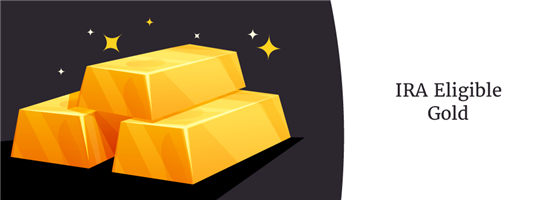What is IRA Eligible Gold
Not all types of gold can be invested in a Gold IRA. Read on to learn about IRA-eligible gold and how it works.
 |
Gold is a good way to protect your wealth, as it has historically retained its value. However, it's considered a collectible, which is prohibited in an IRA. But if collectibles aren't allowed, how do Gold IRAs work?
The IRS has a few exceptions to the collectibles rule. Some types of gold are accepted based on IRC Section 408(m)(3), making them IRA-eligible gold.
Now, what kind of gold meets the criteria for an IRA? Read on.
An IRA is a retirement account where you can invest in most securities available in the market, such as stocks, mutual funds, ETFs, etc. Meanwhile, a Gold IRA is a retirement account containing only precious metals like gold and silver.
What Is IRA-Eligible Gold?
IRA-eligible gold is a type of gold that meets the specific requirements of the IRS to be accepted in a Gold IRA.[1]
This involves the purity of the gold and the producer who minted it. To be accepted in an IRA, the gold bar or coin must:
- Have a fineness or purity of at least 99.5%[2]
- Be minted by a national government
- Not be a collectible or numismatic
While restrictions may be a hassle, the IRS created these rules to ensure the high quality of gold you'll invest in. They also help standardize how to determine the price of gold for liquidity.
Numismatic or collectible gold has intangible factors like rarity and cultural value. This makes standardizing the price for transactions difficult.
Examples of IRA-Eligible Gold
Here are some examples of IRS-eligible gold:
U.S. Mint:
- Gold American Eagle
- American Gold Buffalo
Royal Canadian Mint:
- Gold Maple Leaf
- Gold Canadian Eagle
- Gold Lucky Dragon
New Zealand Mint:
- Gold Liberty
- Gold Innovation | Space Shuttle
- Gold Innovation | Motor Vehicle
- Gold Washington Monument
- Gold Independence Hall
- Gold Freedom
The Perth Mint:
- Gold Australian Striped Marlin
- Gold Phoenix
- Gold Australian Sea Turtle
- Gold American Bald Eagle
- Gold Great Barrier Reef | Stingray
- Gold Australian Saltwater Crocodile
Royal Dutch Mint:
- Gold Freedom & Hope
- Gold Valor
Others
- Gold USS Texas (Scottsdale Mint)
- Gold Military Guinea (East India Company of London)
- Gold British Lunar Series (UK Royal Mint)
All gold in this list has a fineness of 99.99%, except for the American Eagle, which is still eligible even with a 91.67% purity.[3]
While this list is mostly about coins, any gold bar that meets the purity standards required by the IRS will be allowed as well.
How Does a Gold IRA Work?
A Gold IRA is a type of self-directed retirement account that lets you take a hands-off investing approach in precious metals such as gold, silver, palladium, or others.
Just like other IRAs, you get to enjoy tax advantages in a Gold IRA. You can even get tax-free distributions with a Roth Gold IRA.
Here's the step-by-step guide if you want to invest in a Gold IRA:
- Choose a Gold IRA provider
Choose a reliable Gold IRA provider and sign an agreement. You will need to pay a one-time fee to set up your account. - Fund your account
You can opt to roll over some funds from your existing IRA to your Gold IRA, or you can also opt to make a direct deposit to your account. - Buy gold
Your Gold IRA provider should have a readily available list of IRA-eligible gold you can buy for your account.What type of gold investment interests you most for your IRA? - Let your provider store your gold
Your Gold IRA provider works with depositories to store your gold. The IRS does not allow you to store your gold on your own.However, you need to pay your provider an annual storage and admin fee as they store your gold for you.
- Wait until distribution
By age 59½, you can start getting distributions from your Gold IRA. If you withdraw before this, you must pay an additional 10% penalty fee.[4]Also, by age 73, you are required to withdraw a portion of your portfolio according to the required minimum distribution (RMD) table from the IRS. For example, at 73, you need to withdraw 26.5% of your balance.
Gold IRA Pros and Cons
Pros:
- Stored in a depository
- Tax-free for Roth IRAs
- Tax-deductions for Traditional IRAs
- Some providers charge flat fees regardless of quantity
Cons:
- Early withdrawal penalty of 10%
- Does not include collectible coins
- You cannot store the gold anywhere you want
Is a Gold IRA Tax-Free?
A Gold IRA is only tax-free if you have a Roth Gold IRA. A Traditional IRA would still have tax advantages, but only a Roth Gold IRA is tax-free upon withdrawal.
There are many types of IRA accounts, but for simplicity, learn the difference between the two major types.
In a Traditional IRA, your contributions can be tax-deductible in the year it was invested. Your investments grow tax-deferred, meaning you only pay tax when you withdraw them. The withdrawals are taxed as ordinary income.
In a Roth Gold IRA, your contributions are not tax-deductible. However, they grow tax-free. Plus, you also enjoy tax-free withdrawals.
| Contributions | Withdrawals | |
|---|---|---|
| Traditional IRA | Tax-deductible in the year it was invested in | Taxed as ordinary income |
| Roth IRA | Not tax-deductible | Tax-free |
Bottom Line
The IRA eligibility for gold depends on factors like purity and producer.
When you invest through a Gold IRA provider, you don't have to worry about whether or not gold is IRA-approved. They've already filtered out the options for you.
Nevertheless, it's still good to know the details behind your investments. Make sure to understand what types of gold you can invest in.
References
- ^ IRS. Issue snapshot - investments in collectibles in individually-directed qualified plan accounts, Retrieved 05/13/2024
- ^ CME group. What is the Precious Metals Delivery Process?, Retrieved 05/13/2024
- ^ US Code. 31 USC 5112: Denominations, specifications, and design of coins, Retrieved 05/13/2024
- ^ Internal Revenue Service. IRA FAQs - Distributions (Withdrawals), Retrieved 06/23/2024
Write to Stella Magay at feedback@creditdonkey.com. Follow us on Twitter and Facebook for our latest posts.
|
|
|








